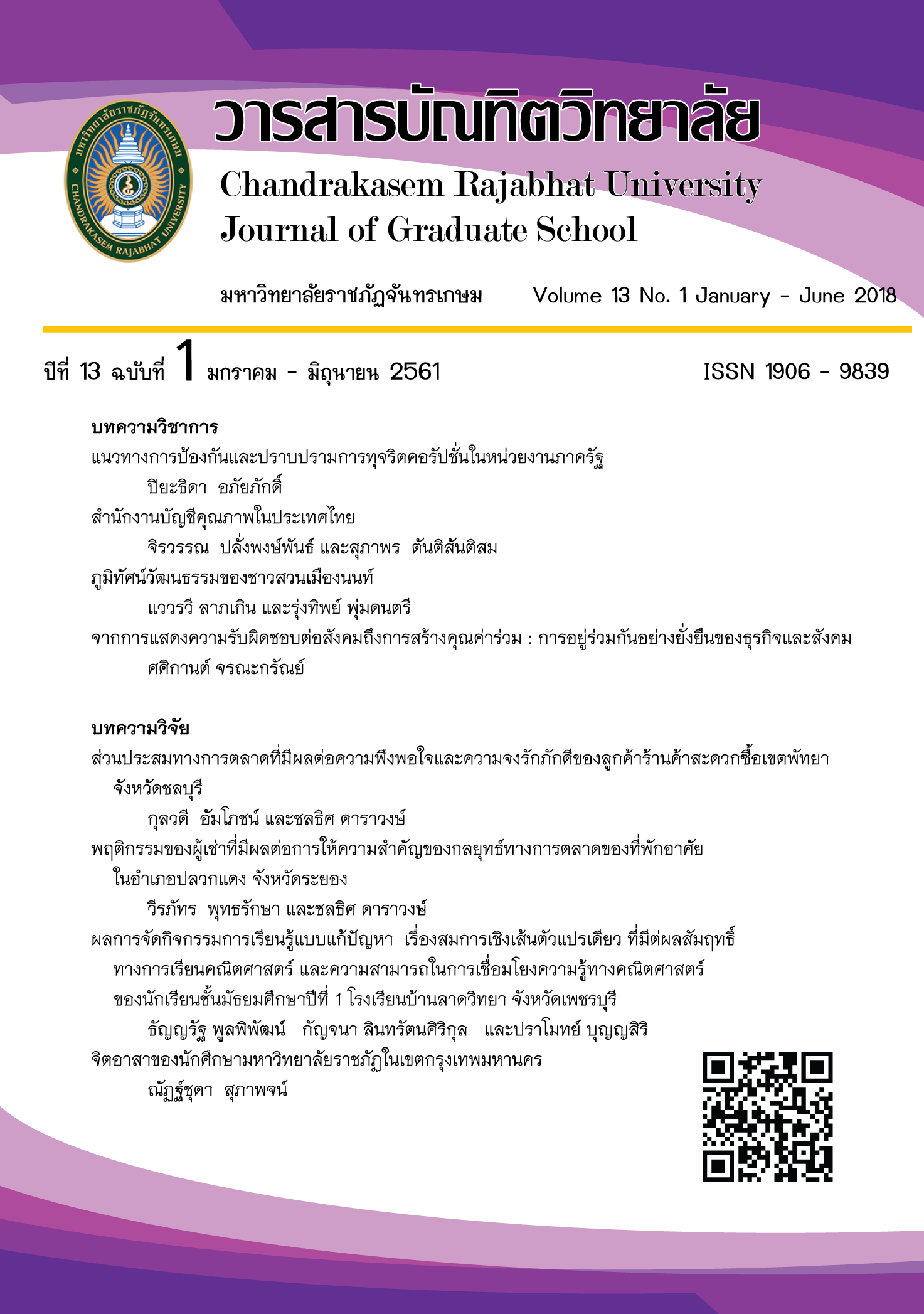ภูมิทัศน์วัฒนธรรมของชาวสวนเมืองนนท์
Main Article Content
บทคัดย่อ
บทความนี้ได้นำเสนอเกี่ยวกับเรื่องภูมิทัศน์วัฒนธรรมของชาวสวนในเขตจังหวัดนนทบุรี ซึ่งจะกล่าวถึง
ภูมิทัศน์วัฒนธรรม ภูมิศาสตร์ทางวัฒนธรรมในด้านความหมาย ที่มาและความสำคัญ วัฒนธรรมในรูปแบบของพลวัตในการขับเคลื่อนและดำรงวิถีชีวิต องค์ประกอบของมรดกทางวัฒนธรรม ที่แบ่งออกเป็น 2 ประเภท คือ มรดกวัฒนธรรมรูปธรรม และมรดกทางวัฒนธรรมแบบนามธรรม ที่กล่าวถึงความสัมพันธ์กันระหว่างวัฒนธรรมที่มีความเกี่ยวข้องกับมนุษย์ สนธิสัญญา นิยามขององค์การยูเนสโกและหน่วยงานที่เกี่ยวข้องในการจัดการภูมิทัศน์ทางวัฒนธรรมอย่างชัดเจน ประเภทของภูมิทัศน์วัฒนธรรม ที่แสดงถึงเกณฑ์ที่กำหนดออกเป็นรูปแบบและประเภทต่าง ๆ การแบ่งกลุ่มของภูมิทัศน์วัฒนธรรม ที่เป็น ภูมิทัศน์วัฒนธรรมของพื้นที่ทางประวัติศาสตร์ที่ได้รับการออกแบบ
ภูมิทัศน์ของพื้นที่ทางวัฒนธรรมแบบพื้นถิ่น ภูมิทัศน์วัฒนธรรมของพื้นที่ประวัติศาสตร์ และภูมิทัศน์วัฒนธรรมของกลุ่มชน ความเป็นย่านแหล่งปลูกผลไม้ขนาดใหญ่และทุเรียนที่มีชื่อเสียงแห่งหนึ่งในประเทศไทยในอดีต และแนวทางในการจัดการภูมิทัศน์วัฒนธรรมของชาวสวนเมืองนนท์ที่ถ่ายทอดออกมาในรูปแบบของภูมิปัญญา วิธีการในการดำเนินวิถีชีวิตของชาวสวนที่ศึกษา วิธีการจัดการและปรับตัวกับสภาพแวดล้อมทางภูมิศาสตร์ ดิน น้ำ และอากาศที่เปลี่ยนแปลงไป การสร้างที่อยู่อาศัยที่เหมาะสมกับการเป็นพื้นที่ราบลุ่มน้ำท่วมถึง การทำสวนผลไม้ของชาวสวนจังหวัดนนทบุรีนั้น เป็นวิธีการและแนวคิดที่แฝงไปด้วยการพึ่งพาระหว่างคนกับธรรมชาติ และการพึ่งพาระหว่างธรรมชาติกับธรรมชาติ โดยอาศัยหลักและแนวคิดจากระบบนิเวศวิทยาวัฒนธรรม มาประยุกต์ใช้อย่างเป็นรูปธรรม ท่ามกลางความเปลี่ยนแปลงของสภาพภูมิทัศน์ทางวัฒนธรรม ระหว่างชุมชนกับความเป็นเมืองได้อย่างยั่งยืน
Article Details
เอกสารอ้างอิง
กัญญ์ ยังน้อย. (2553). แนวทางการอนุรักษ์ฟื้นฟูภูมิปัญญาการปลูกทุเรียนเมืองนนท์ เพื่อเพิ่มมูลค่าเศรษฐกิจชุมชน
(ปริญญาหาบัณฑิต) มหาสารคม: มหาวิทยาลัยมหาสารคาม.
เกรียงไกร เกิดศิริ. (2551). ชุมชนกับภูมิทัศน์วัฒนธรรม. (พิมพ์ครั้งที่ 1). กรุงเทพฯ: อุษาคเนย์
ญาณี สรประไพ. (2538). การสืบเนื่องและการเปลี่ยนแปลงทางสังคมวัฒนธรรมชาวสวนจังหวัดนนทบุรี
(ปริญญามหาบัณฑิต) กรุงเทพฯ: มหาวิทยาลัยศิลปากร.
เดอลาลูแบร์. (2510). จดหมายเหตุลาลูแบร์ ราชอาณาจักรสยาม. (สันต์ ท. โกมลบุตร, ผู้แปล). พระนคร: ก้าวหน้า.
ธนิก เลิศชาญฤทธ์. (2554). การจัดการทรัพยากรวัฒนธรรม. (พิมพ์ครั้งที่ 1). กรุงเทพฯ: เคล็ดไทย.
ราชบัณฑิตยสถาน. (2549). พจนานุกรมภูมิศาสตร์. (พิมพ์ครั้งที่ 4). กรุงเทพฯ: ชวนพิมพ์
ราชบัณฑิตยสถาน. (2560). ภูมิศาสตร์. สืบค้น 25 เมษายน 2560, จาก http://www.royin.go.th/dictionary/
วิวัฒน์ เตมียพันธ์ และคณะ. (2547). มรดกความงามของสภาพแวดล้อมท้องถิ่นไทย. กรุงเทพฯ:
สถาบันเทคโนโลยีพระจอมเกล้าเจ้าคุณทหารลาดกระบัง.
ศรีศักร วัลลิโภดม. (2551). คู่มือฉุกคิด ความหมายของภูมิวัฒนธรรม การศึกษาจากภายในและสำนึกของ
ท้องถิ่น (พิมพ์ครั้งที่ 1). กรุงเทพฯ: มูลนิธิเล็ก-ประไพ วิริยะพันธุ์.
ศูนย์มานุษยวิทยาสิรินธร. (2554). ภูมิศาสตร์วิถีชีวิตไทย. (พิมพ์ครั้งที่ 2). กรุงเทพฯ: อมรินทร์พริ้นติ้งแอนด์พับลิชชิ่ง.
Folwer, P. (2002). Cultural Landscape. World Heritage Paper, (6), 18.
UNESCO. (2560). Cultland. สืบค้น 26 เมษายน 2560, จาก http://whc.unesco.org/exhibits/cultland/categories.htm
Wagner P.L, & Mikesell M.W. (1962). Reading in Cultural Geography. Chicago: University of Chicago Press.


